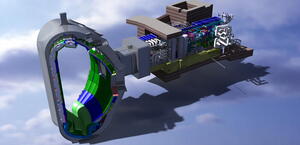Tritium breeding

ITER will offer a unique opportunity to test mockups of tritium breeding blankets—a key technology for future fusion reactors—in a real fusion environment. Pictured is a test blanket module and its auxiliary systems in one of the two port cells dedicated to testing tritium breeding.
In the deuterium-tritium (D-T) fusion reaction, high energy neutrons are released along with helium atoms. These electrically neutral particles escape the magnetic fields that confine the plasma and are absorbed by the blanket covering the surrounding walls.
If the blanket modules contain lithium, a reaction occurs: the incoming neutron is absorbed by the lithium atom, which recombines into an atom of tritium and an atom of helium. The tritium can then be removed from the blanket and recycled into the plasma as fuel.
Blankets containing lithium are referred to as breeding blankets. A future fusion plant producing large amounts of power will be required to "breed" all of its own tritium. Through its Test Blanket Module (TBM) program, ITER will be the first fusion device to test this essential concept of tritium self-sustainment. Further research will be necessary to demonstrate the feasibility of large-scale tritium production and recycling.
ITER Test Blanket Module (TBM) Program
ITER will experiment with tritium production within the vacuum vessel by way of test blanket modules (TBMs). Four different test blanket module concepts are being developed by the ITER Members: water-cooled lithium-lead (Europe); water-cooled ceramics breeder (Japan); helium-cooled ceramics breeder (China); and helium-cooled ceramic pebbles (Europe/Korea). All ITER Domestic Agencies are carrying out R&D on different aspects of the test blanket systems (i.e., coolant, materials, tritium extraction...).
These concepts will be simultaneously installed in two equatorial ports of the ITER machine and operated to test the efficiency of tritium breeding and extraction systems. The design of the various test blanket systems (breeding modules + auxiliary systems) is progressing.
In addition to demonstrating the generation of tritium within a closed fuel cycle, ITER's Test Blanket Module Program has a second purpose—experimenting with different coolants for the future power-to-electricity conversion cycle. While the power produced in ITER will be mainly captured by cooling water circulating in the blanket and sent to ITER's heat rejection system, in next-phase DEMO machines and beyond, the power carried by the coolant will be transferred to a power cycle fluid through a heat exchanger. For this, a high-temperature coolant will be required for economically acceptable power cycle efficiency. With this in mind, ITER's test blanket modules will be tested with their own independent cooling systems.
